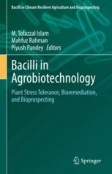Search
Search Results
-
Susceptibility of Diatraea saccharalis Populations (Lepidoptera: Crambidae) to Bt Toxins Expressed in Genetically Modified Corns for Development of Transgenic Sugarcane in Argentina
The sugarcane borer, Diatraea saccharalis , is one of the most important pests of sugarcane and corn crops in Argentina. In general, there are no...

-
Development of transgenic cotton (Narasimha) using triple gene Cry2Ab-Cry1F-Cry1Ac construct conferring resistance to lepidopteran pest
High-yielding Indian cotton varieties are not amenable for regeneration and transformation because they are recalcitrant in nature. In this work, we...

-
Transgenic tobacco expressing a novel Bt gene, cry1AcF, show resistance against fall armyworm (Spodoptera frugiperda)
Spodoptera frugiperda is a notorious insect-pest that causes massive yield losses to several agriculturally important food crops every year. S....

-
Degradation of transgenic Bacillus thuringiensis proteins in corn tissue in response to post-harvest management practices
Knowledge of the persistence of Cry proteins in transgenic corn residue after harvest is necessary to assess the ecological risk to nontarget...

-
Effect of Bt zygosity in transgenic maize hybrids to the non-target pest Dalbulus maidis
The corn leafhopper Dalbulus maidis causes corn production losses mainly by acting as vector of pathogenic mollicutes and virus. Transgenic...

-
Draft genome of neotropical Bacillus thuringiensis UFT038 and its potential against lepidopteran soybean pests
Bacillus thuringiensis ( Bt ) is known for its Cry and Vip3A pesticidal proteins with high selectivity to target pests. Here, we assessed the potential...

-
Diversity of Bt toxins and their utility in pest management
BackgroundThe rising demand for food production along with the concerns regarding the injudicious use of chemicals in pest management has paved way...

-
Biological control of Spodoptera frugiperda (Nixon) (Lepidoptera: Noctuidae) in new invaded countries using insect pathogens
BackgroundThe fall armyworm (FAW), Spodoptera frugiperda (J.E. Nixon) (Lepidoptera: Noctuidae), is the major insect pest that infests cereal crops...
-
The invasive fall armyworm, Spodoptera frugiperda, in Africa and Asia: responding to the food security challenge, with priorities for integrated pest management research
In sub-Saharan Africa (SSA) and several Asian countries, maize continues to be a major staple food for millions of people. It plays an important role...

-
CRISPR/Cas9: a cutting-edge solution for combatting the fall armyworm, Spodoptera frugiperda
The utilization of CRISPR/Cas9 in Spodoptera frugiperda , commonly known as fall armyworm, presents a groundbreaking avenue for pest management. With...

-
Critical Evaluation of GM Cotton
Over the past 24 years, biotech cotton has been influencing global cotton production systems. Genetically modified (GM) cotton or biotech cotton has...
-
Climate Change Poses Threat to Helicoverpa zea Boddie (Lepidoptera: Noctuidae)
Increasing global temperature causes both biotic and abiotic stresses on living organisms. Changing climates have an effect on the existence of pests...
-
Strategic Analysis of Collaborative Networks in Spodoptera frugiperda (Lepidoptera: Noctuidae) Research for Improved Pest Management Strategies
The fall armyworm (FAW) poses a significant global threat to food security, and economics. Timely detection is crucial, and this research explores...

-
Fluorescence of chlorophyll a in transgenic maize with herbicide application and attacked by Spodoptera frugiperda (Lepidoptera: Noctuidae)
Physiological changes in maize plants, submitted to herbicides and pests, should be studied for integrated management in this crop. The objective was...
-
Physiological responses in genetically modified cotton and its isohybrid attacked by Aphis gossypii Glover (Hemiptera: Aphididae)
In Brazil, genetically modified cotton is increasing in most cultivated areas to manage insects, mainly Lepidoptera. Pests associated with cotton...

-
Management of Noctuid Pests Using Genetic Tools
Noctuid moth pests are the most serious pests of crops. Many noctuids are invasive, spreading to different parts of the world. Insecticides are...
-
Bacillus thuringiensis Proteins: Structure, Mechanism and Biological Control of Insect Pests
Bacillus thuringiensis (Bt) produces a wide variety of insecticidal proteins. It synthesizes δ-endotoxins as parasporal crystalline inclusion bodies...
-
The oviposition behavior of fall armyworm moths is unlikely to compromise the refuge strategy in genetically modified Bt crops
Non-random oviposition preference by target pest species on Bt and non-Bt refuge plants may increase the proportion of the population under selection...

-
Host plant resistance for fall armyworm management in maize: relevance, status and prospects in Africa and Asia
Key messageSustainable control of fall armyworm (FAW) requires implementation of effective integrated pest management (IPM) strategies, with host...

-
Genetically Modified Cereal Crops Regulation Policies
The history of crop genetic manipulation through conventional breeding (artificial selection and selective breeding) dates back to more than...
